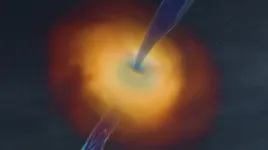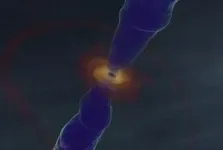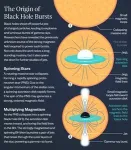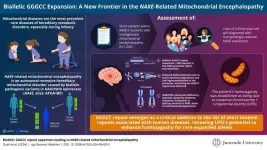(Press-News.org) Black holes are one of the most enigmatic stellar objects. While best known for swallowing up their surroundings into a gravity pit from which nothing can escape, they can also shoot off powerful jets of charged particles, leading to explosive bursts of gamma rays that can release more energy in mere seconds than our sun will emit in its entire lifetime. For such a spectacular event to occur, a black hole needs to carry a powerful magnetic field. Where this magnetism comes from, however, has been a long-standing mystery.
Using calculations of black hole formation, scientists at the Flatiron Institute and their collaborators have finally found the origin of those magnetic fields: the collapsing parent stars of the black holes themselves. The researchers report their results November 18 in The Astrophysical Journal Letters.
Black holes can form after a star explodes as a supernova, leaving behind a dense remnant core called a proto-neutron star.
“Proto-neutron stars are the mothers of black holes in that when they collapse, a black hole is born. What we are seeing is that as this black hole forms, the proto-neutron star’s surrounding disk will essentially pin its magnetic lines to the black hole,” says Ore Gottlieb, the study’s first author and a research fellow at the Flatiron Institute’s Center for Computational Astrophysics (CCA) in New York City. “It’s very exciting to finally understand this fundamental property of black holes and how they power gamma ray bursts — the most luminous explosions in the universe.”
Gottlieb co-authored the study with fellow CCA researchers Brian Metzger, Jared Goldberg, Matteo Cantiello and Mathieu Renzo.
The Magnetism Mystery
The team initially aimed to model a star’s journey from birth to collapse to black hole formation. With their simulations, the team planned to study outflows from the black hole, like jets that generate gamma ray bursts. However, Gottlieb’s team ran into a problem with the models.
“We were not sure how to model behavior of these magnetic fields during the collapse of the neutron star to the black hole,” Gottlieb says. “So, this was a question that I started to think about for the first time.”
There were a few theories surrounding black holes and their magnetism, but none seemed to add up when accounting for the power of a black hole’s jets and gamma ray bursts.
“What had been thought to be the case is that the magnetic fields of collapsing stars are collapsing into the black hole,” says Gottlieb. “During this collapse, these magnetic field lines are made stronger as they are compressed, so the density of the magnetic fields become higher.”
The problem with that explanation was that strong magnetism in the star causes the star to lose its rotation. And without rapid rotation, a newborn black hole can’t form an accretion disk — the flow of gas, plasma, dust and particles around a black hole — and could not produce the jets and gamma ray bursts we’ve observed.
“It appears to be mutually exclusive,” says Gottlieb. “You need two things for jets to form: a strong magnetic field and an accretion disk. But a magnetic field acquired by such compression won’t form an accretion disk, and if you reduce the magnetism to the point where the disk can form, then it’s not strong enough to produce the jets.”
This meant something else was going on, and the scientists aimed to find out what it was by going straight to the source: a black hole’s parent.
A Black Hole’s Magnetic Parent: The Neutron Star
The scientists realized that perhaps previous simulations of collapsing neutron stars weren’t giving the full picture.
“Past simulations have only considered isolated neutron stars and isolated black holes, where all magnetism is lost during the collapse. However, we found that these neutron stars have accretion disks of their own, just like black holes,” says Gottlieb. “And so, the idea is that maybe an accretion disk can save the magnetic field of the neutron star. This way, a black hole will form with the same magnetic field lines that threaded the neutron star.”
The team’s calculations showed that as a neutron star collapses, before all its magnetic field is swallowed up by the newly formed black hole, the neutron star’s disk is inherited by the black hole and its magnetic field lines become anchored.
“We ran calculations for the typical values that we expect to see in these systems, and in most cases, the timescale for black hole disk formation is shorter than that of the black hole losing its magnetism,” says Gottlieb. “So the disk enables the black hole to inherit a magnetic field from its mother, the neutron star.”
Implications Across the Cosmos
Gottlieb is excited about the new discovery not only because it solves a longstanding mystery but also because it opens the door for further studies of jets.
“This study changes the way we think about what types of systems can support jet formation because if we know that accretion disks imply magnetism, then in theory, all you need is an early disk formation to power jets,” he says. “I think it would be interesting for us to rethink all of the connections between populations of stars and jet formation now that we know this.”
Gottlieb credits team science and the capabilities at CCA for making this work possible.
“This was a multidisciplinary collaboration that enabled us to address this question from different directions and form a coherent picture of a star’s evolution post-collapse,” he says. “And the generous computational resources of CCA let us run simulations of the collapse more consistently than has ever been done before. I think these two aspects led to an innovative approach.”
ABOUT THE FLATIRON INSTITUTE
The Flatiron Institute is the research division of the Simons Foundation. The institute's mission is to advance scientific research through computational methods, including data analysis, theory, modeling and simulation. The institute's Center for Computational Astrophysics creates new computational frameworks that allow scientists to analyze big astronomical datasets and to understand complex, multi-scale physics in a cosmological context.
END
We finally know where black holes get their magnetic fields: Their parents
Simulations of exploded highly magnetized stars collapsing into black holes reveal that they ‘pass down’ their magnetic fields to their newly formed black hole’s surrounding disk of swirling matter.
2024-11-18
ELSE PRESS RELEASES FROM THIS DATE:
Multiple sclerosis drug may help with poor working memory
2024-11-18
Fampridine is currently used to improve walking ability in multiple sclerosis. A new study shows that it could also help individuals with reduced working memory, as seen in mental health conditions like schizophrenia or depression.
Remembering a code for long enough to type it in; holding a conversation and reacting appropriately to what is being said: in everyday situations like these, we use our working memory. It allows a memory to be actively retained for a few seconds. Certain conditions, such as schizophrenia ...
The MIT Press releases workshop report on the future of open access publishing and policy
2024-11-18
Cambridge, MA (November 18, 2024) – Today the MIT Press is releasing a workshop report on what additional information is needed to ensure that open access publication benefits research, entitled "Access to Science & Scholarship 2024: Building an Evidence Base to Support the Future of Open Research Policy." The report is the outcome of a workshop funded by the National Science Foundation and held at the D.C. headquarters of the American Association for the Advancement of Science on September 20, 2024.
The implementation of open access has resulted in consolidation of the publishing industry, an explosion in unreviewed articles, and new costs that may be hard ...
Why substitute sugar with maple syrup?
2024-11-18
Quebec, CA, November 18, 2024 – A new study published in the The Journal of Nutrition, found that substituting two tablespoons of pure maple syrup for refined sugars reduced several cardiometabolic risk factors in humans. It was the first placebo-controlled clinical trial exploring potential health benefits of maple syrup in humans.
“We know from decades of research that maple syrup is more than just sugar. It contains over 100 natural compounds, including polyphenols, that are known to prevent disease in part through their anti-inflammatory ...
New study investigates insecticide contamination in Minnesota’s water
2024-11-18
MINNEAPOLIS / ST. PAUL (11/18/2024) — A new study by researchers at the University of Minnesota Twin Cities in collaboration with the Minnesota Department of Natural Resources (DNR) found that specific insecticides, called neonicotinoids, were found at high concentrations in some ground and surface water sources that could affect drinking water.
Individuals relying on shallow groundwater or natural springs for drinking water have a higher risk of contamination from these insecticides compared to those getting their drinking water from deep groundwater wells. ...
The Einstein Foundation Berlin awards €500,000 prize to advance research quality
2024-11-18
The €500,000 Einstein Foundation Award for Promoting Quality in Research honors researchers and institutions whose work helps to fundamentally advance the quality and robustness of research findings. The award is bestowed jointly with the QUEST Center for Responsible Research, Berlin Institute of Health (BIH) at Charité. „The Einstein Foundation Award seeks to amplify the importance of quality and accountability in research, particularly as science plays a critical role in addressing global challenges,“ explains Martin Rennert, Chair of the Einstein Foundation’s Executive Board. ...
Mitochondrial encephalopathy caused by a new biallelic repeat expansion
2024-11-18
Mitochondrial diseases are among the most prevalent hereditary metabolic disorders, known to occur in one out every 5000 births. Single nucleotide variations, indels, and structural variations are known to cause these disorders. While many arise from single nucleotide variations, indels, or structural variants, some forms are also triggered by repeat expansions in nuclear genes affecting mitochondrial function, which can result in severe mitochondrial dysfunction. These diseases often impact the central nervous system (CNS), and mitochondrial encephalopathies represent a subset characterized by prominent ...
Nanoplastics can impair the effect of antibiotics
2024-11-18
Minuscule particles of plastic are not only bad for the environment. A study led from Umeå University, Sweden, has shown that the so-called nanoplastics which enter the body also can impair the effect of antibiotic treatment. The results also indicate that the nanoplastics may lead to the development of antibiotic resistance. Even the indoor air in our homes contains high levels of nanoplastics from, among other things, nylon, which is particularly problematic.
"The results are alarming considering how common nanoplastics are and because effective antibiotics for many can be the difference between life and death," says Lukas Kenner, ...
Be humble: Pitt studies reveal how to increase perceived trustworthiness of scientists
2024-11-18
How can scientists across climate science, medical and psychological topics foster the public’s trust in them and their science? Show that they are intellectually humble.
Those are some of the findings of two intellectually humble University of Pittsburgh scientists and their co-authors, using five separate studies totaling 2,034 participants in research published Nov. 18 in Nature Human Behaviour.
“Research has shown that having intellectual humility — which is an awareness that one’s knowledge or beliefs might be incomplete or wrong — is associated with engaging in more effortful and less biased information processing,” said Jonah Koetke, ...
Promising daily tablet increases growth in children with dwarfism
2024-11-18
A promising daily tablet is effective at increasing height and improving proportional limb growth in children with achondroplasia, the most common form of dwarfism, according to a new study. And the findings could spare these children from needing to have a daily injection to boost growth.
The phase II study, led by Murdoch Children’s Research Institute (MCRI) and published in the New England Journal of Medicine, found the drug infigratinib, an investigational product, was safe and effective in treating children with achondroplasia aged 3-11 ...
How 70% of the Mediterranean Sea was lost 5.5 million years ago
2024-11-18
Mediterranean Sea dropped during the Messinian Salinity Crisis – a major geological event that transformed the Mediterranean into a gigantic salt basin between 5.97 and 5.33 million years ago2.
Until now, the process by which a million cubic kilometres of salt accumulated in the Mediterranean basin over such a short period of time remained unknown. Thanks to analysis of the chlorine isotopes3 contained in salt extracted from the Mediterranean seabed, scientists have been able to identify the ...
LAST 30 PRESS RELEASES:
New expert guidance urges caution before surgery for patients with treatment-resistant constipation
Solar hydrogen can now be produced efficiently without the scarce metal platinum
Sleeping in on weekends may help boost teens’ mental health
Study: Teens use cellphones for an hour a day at school
After more than two years of war, Palestinian children are hungry, denied education and “like the living dead”
The untold story of life with Prader-Willi syndrome - according to the siblings who live it
How the parasite that ‘gave up sex’ found more hosts – and why its victory won’t last
When is it time to jump? The boiling frog problem of AI use in physics education
Twitter data reveals partisan divide in understanding why pollen season's getting worse
AI is quick but risky for updating old software
Revolutionizing biosecurity: new multi-omics framework to transform invasive species management
From ancient herb to modern medicine: new review unveils the multi-targeted healing potential of Borago officinalis
Building a global scientific community: Biological Diversity Journal announces dual recruitment of Editorial Board and Youth Editorial Board members
Microbes that break down antibiotics help protect ecosystems under drug pollution
Smart biochar that remembers pollutants offers a new way to clean water and recycle biomass
Rice genes matter more than domestication in shaping plant microbiomes
Ticking time bomb: Some farmers report as many as 70 tick encounters over a 6-month period
Turning garden and crop waste into plastics
Scientists discover ‘platypus galaxies’ in the early universe
Seeing thyroid cancer in a new light: when AI meets label-free imaging in the operating room
Neutrophil-to-lymphocyte ratio may aid risk stratification in depressive disorder
2026 Seismological Society of America Annual Meeting
AI-powered ECG analysis offers promising path for early detection of chronic obstructive pulmonary disease, says Mount Sinai researchers
GIMM uncovers flaws in lab-grown heart cells and paves the way for improved treatments
Cracking the evolutionary code of sleep
Medications could help the aging brain cope with surgery, memory impairment
Back pain linked to worse sleep years later in men over 65, according to study
CDC urges ‘shared decision-making’ on some childhood vaccines; many unclear about what that means
New research finds that an ‘equal treatment’ approach to economic opportunity advertising can backfire
Researchers create shape-shifting, self-navigating microparticles
[Press-News.org] We finally know where black holes get their magnetic fields: Their parentsSimulations of exploded highly magnetized stars collapsing into black holes reveal that they ‘pass down’ their magnetic fields to their newly formed black hole’s surrounding disk of swirling matter.








